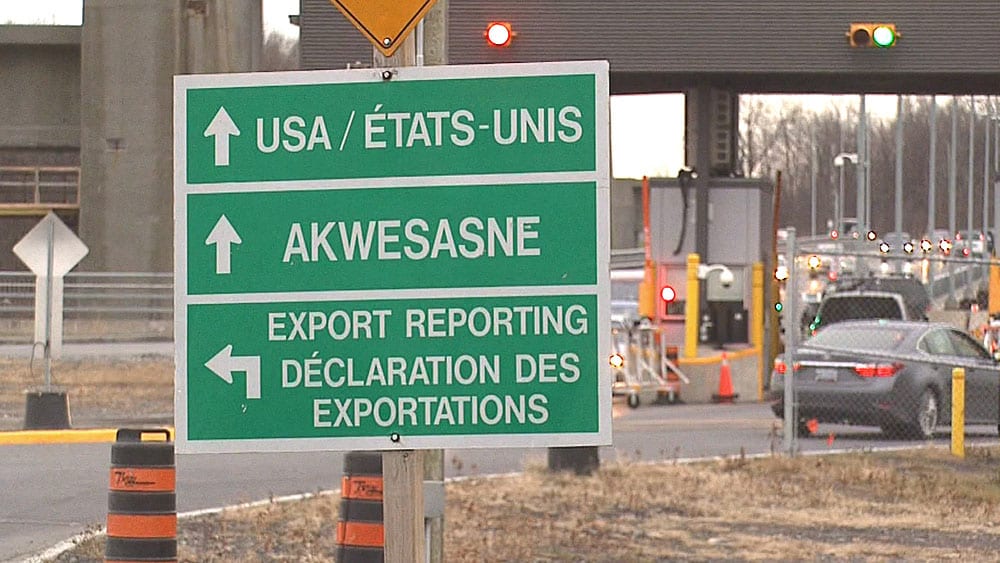
The grand chief of the Mohawk Council of Akwesasne says he plans to scrutinize case numbers in nearby jurisdictions over the next month before deciding whether or not to follow suit, loosen lockdown measures and re-open for business.
“We’re really trying to take a bit of a slower approach,” Abram Benedict told APTN News. “We’re continuing to remind people that a spike in the cases or even a second wave really rests on our shoulders as far as what actions we take – and not to be too relaxed about what’s going on.”
Akwesasne is a Mohawk community which straddles the U.S. and Canada border. The territory is roughly 125 kilometres east of Ottawa and also stretches into Quebec. About half of the community’s over 20,000 residents live on the American side in the state of New York.
Benedict says they’ll analyze case numbers closely in those jurisdictions before lifting restrictions.
A community curfew remains in place and Benedict says they haven’t told businesses when to open yet.
The prime minister announced Tuesday that Canada and the U.S. agreed to extend the border closure for 30 days, which gives the community time to see what happens.
Despite concerns over through-traffic bringing in COVID-19, the community avoided a major outbreak. Benedict says he finds it challenging being on the border, watching Canada and America take such different approaches reopening their respective economies. The focus remains on what’s best for community members.
“We tell the community what’s in the best interest locally. It’s not about what’s going on in other parts of America. It’s really about what’s happening here in our community. It’s real. The threat is real,” he said.
Read more:
Mohawks of Kanesatake appeal to province as Oka tries to take down check points
First Nations set up blockades to prevent construction of Keeyask Hydro project
Walpole Island First Nation is in a similar situation. Located in southwestern Ontario, the community sits next to the Michigan border and operates an international ferry that closed in March. Confirmed cases of the novel coronavirus rose quickly from zero to 11 in the community and one person died after contracting the virus, though most have recovered.
The community also welcomes the border closure, says Director of Operations James Jenkins.
“It does seem as though the communities across the border were experiencing a higher number of COVID-19 cases, and so I think it was a bit alarming. I think most of the communities along the border in our region are thankful that there’s border crossing restrictions at this point in time,” he said.
Leadership plans to monitor and analyze Ontario’s decisions before deciding what to do, he adds. A bridge checkpoint has restricted non-essential travel into the territory since April and remains in place.
“Since Ontario loosened the number of restrictions this week, we haven’t followed suit because we’re continuing to monitor and try to determine whether or not we may still be peaking in our community,” he said. “There’s a sense that it may have hit First Nations a bit later than Ontario, so we’re continuing to monitor that.”
APTN asked the prime minister on Wednesday whether he supports extra measures some First Nations communities are taking, which have created tension with nearby jurisdictions in some cases. He did not answer the question directly but encouraged local stakeholders, including Indigenous leadership, to work together on decisions about reopening.
Last week, Dr. Tom Wong, chief medical officer at Indigenous Services Canada (ISC), urged different jurisdictions to “recognize the inherent rights and self-determination of First Nations, Inuit and Metis people” on decisions about reopening.
Concerns aren’t limited to communities with border crossings, either.
The municipality of Oka is at odds with the Mohawk territory of Kanesatake over checkpoints limiting travel though the community.
Kahnawake extended its state of emergency for another month while Montreal, just to the north, is opening up. Ontario Regional Chief RoseAnne Archibald called for co-operation and calm earlier this month after a First Nation-led non-essential travel ban on Manitoulin Island created tension with nearby municipalities.
Northern communities are worried too.
A public health order issued Tuesday by Saskatchewan’s top doctor restricts non-essential travel in and out of the coronavirus-hit northwestern region of the province where many First Nations and Metis communities are located. The province previously issued a similar order and took over roadside checkpoints manned by community members. Two First Nations in northern Manitoba erected a blockade to try and stop an influx of workers from coming in to a nearby hydroelectric generating station.
Jenkins says his community tried to avoid tension by reaching out early and asking cottagers who have secondary residences on the territory to stay home, but concerns remain over cottagers in America wondering when they can visit.
For now, leadership wants the community to keep current public health measures in place.
“We’re definitely encouraging everyone to stay in lockdown and continue the physical distancing,” said Jenkins.
“We’re not seeing the kind of traffic we were before we had the checkpoint in place, so it’s helping quite a bit.”
-With files from Lindsay Richardson and Jamie Pashagumskum









